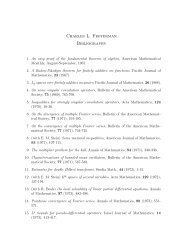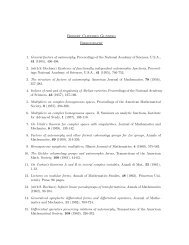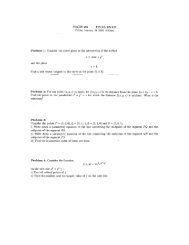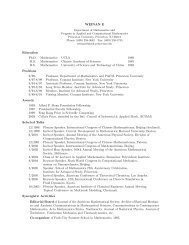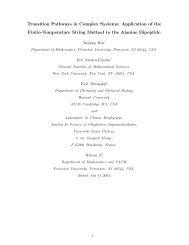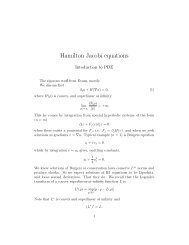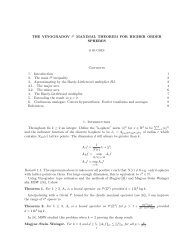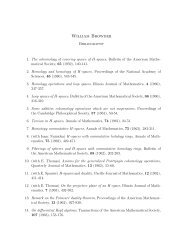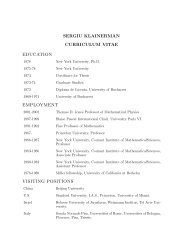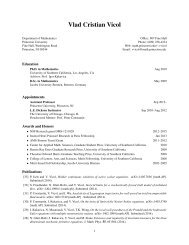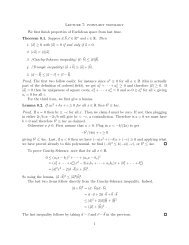The rational Khovanov homology of 3-strand pretzel links
The rational Khovanov homology of 3-strand pretzel links
The rational Khovanov homology of 3-strand pretzel links
You also want an ePaper? Increase the reach of your titles
YUMPU automatically turns print PDFs into web optimized ePapers that Google loves.
THE RATIONAL KHOVANOV HOMOLOGY OF 3-STRAND PRETZEL LINKS 23<br />
Since V is the <strong>Khovanov</strong> <strong>homology</strong> <strong>of</strong> a <strong>pretzel</strong> knot (up to a shift), we may write<br />
V = L ⊕ U as in Definition 2.10. By induction, and because <strong>of</strong> the grading shifts<br />
in the above sequence, L is based at (q,t) = ((−m − (n − 1)) + (n − l − 1), (−2m −<br />
2(n − 1) − 1) + (3n − 3l − 2)) = (−l − m, −3l − 2m + n − 1). Similarly, U is based<br />
at (l − m + 1,l − 2m + n − 1). Note that these values match up with the LL row <strong>of</strong><br />
Table 1, which is good since P(−l,m,n) is oriented LL.<br />
To analyze the cancellations, we will fix some notation. As we just noted, W has<br />
two exceptional pairs, one in t = 0 and the other in t = n − l. Pick generators {e 1 ,e 2 }<br />
for the first exceptional pair and {f 1 ,f 2 } for the second, such that e 1 and f 1 have the<br />
higher q-gradings (Figure 10 shows the case m = l + 1).<br />
First consider the case m = l + 1, as in Figure 10. No generators <strong>of</strong> W except for<br />
the e i and f i could possibly cancel. If either <strong>of</strong> the e i ’s cancelled, X could not have an<br />
exceptional pair in t = 0, a contradiction. On the other hand, both f i ’s must cancel for<br />
X to be well-structured, since X has no exceptional pairs except in t = 0.<br />
<strong>The</strong> result <strong>of</strong> these cancellations is that, first, L loses its exceptional pair. Definition<br />
2.5(1) shows that this behavior is precisely what was predicted for the lower<br />
summand <strong>of</strong> P(l,l + 1,n), in contrast with Definition 2.5(3). We already saw that L<br />
was based at the correct point. Figure 10 shows that we also pick up an upper summand<br />
from W ′ , where W ′ denotes W without its top exceptional pair. Recall that V did not<br />
start with an upper summand. <strong>The</strong> new upper summand is based at (0,n − l − 3), in<br />
accord with row LL <strong>of</strong> Table 1. It has the correct form as specified in Definition 2.6(3),<br />
since the formula there in the case g = 0 just gives the <strong>Khovanov</strong> <strong>homology</strong> <strong>of</strong> T n−l,2<br />
(minus the top exceptional pair), up to a grading shift.<br />
Now consider the case m > l + 1 (m is still assumed to be even). L is based at<br />
t = −l − m, and it occupies 2l + 1 columns, so the highest t-grading <strong>of</strong> L is l − m. But<br />
this value is less than −1, while the lowest t-grading in W is 0. Hence no cancellations<br />
between L and W can occur, and we have X = L ⊕ X ′ where X ′ is a cancellation <strong>of</strong><br />
U ⊕ W. Note that both U and W are contained in the same two adjacent δ-gradings,<br />
namely δ = n − l − 1 and δ = n − l − 3.<br />
Now, Kh(P(−l,m − 1,n)) has zero as its highest t-grading (its one exceptional pair<br />
lies in its highest t-grading, so this grading must be 0). Hence V (or equivalently U)<br />
has n − l − 1 as its highest t-grading, and it has an exceptional pair in this column.<br />
Also, W has one <strong>of</strong> its two exceptional pairs in t = n −l. Lemma 3.9 applies, and there<br />
is a standard cancellation between t = n − l − 1 and t = n − l.<br />
Now Remark 3.7 applies, and any further cancellations would be cancellations <strong>of</strong><br />
U ′ ⊕ W ′ (using the notation <strong>of</strong> Remark 3.7). But U ′ no longer has any exceptional<br />
pairs, and W ′ only has one <strong>of</strong> them. <strong>The</strong> exceptional pair <strong>of</strong> X must be contained in<br />
its upper summand X ′ , so it must come from U ′ ⊕W ′ . Thus, by Lemma 3.6, no further<br />
cancellations are possible.<br />
It is easy now to verify our formula inductively. Recall that U began its life in the<br />
form <strong>of</strong> Definition 2.6(1). <strong>The</strong> standard cancellation just replaces the exceptional pair




